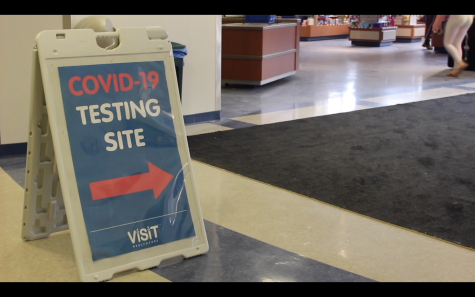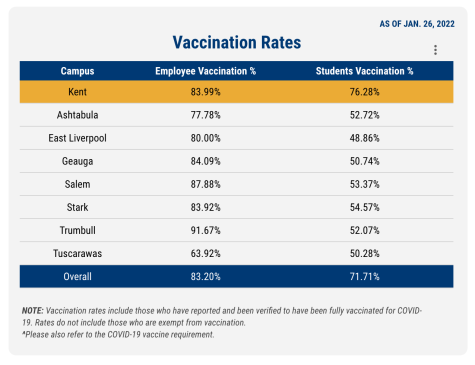KSU fall 2021 COVID-19 preparations
May 14, 2021
The COVID-19 pandemic has brought many changes to Kent State and many of the safety precautions will continue into the fall. KSU and the city of Kent will be working together to ensure safety for residents and students.
Distancing between students will be reduced from six foot to three foot distancing. There will still be a six-foot distancing between instructors and students. Lawrence Terkel, a religious studies professor, is comfortable with the three-foot distance because he is fully vaccinated and believes most of the students will be by the time classes start.
Flashes Safe Eight is not being adjusted as of right now, said Manfred van Dulmen, interim associate provost for academic affairs.
“The CDC and the state will adjust its guidelines regularly,” van Dulmen said. “As they are updating their guidelines, we will review our safety measures and protocols in conjunction with the city of Kent and the city of Kent’s health commissioner, Joan Seidel.”
“We’re working with the university to look at what would be our ideal and then what would we do next if say the virus is really surging in our community,” said Joan Seidel, the city of Kent health commissioner, about the COVID-19 planning with the university.
The university wants to make sure practices are consistent with people’s experiences on and off campus.
Seidel wants unvaccinated people at the university and around the Kent community to remember three numbers: 10, six and one.
“There should be groups no larger than 10, everyone should stay six feet apart from other groups and individuals that they are not used to being around and that everyone should wear a mask if they are interacting with individuals that are not in their usual groups,” Seidel said.
Six feet apart and masking does not pertain to those who are considered fully vaccinated and are in their own home or those who are around their usual group from the direction of the CDC.
Terkel has been teaching in person since the pandemic started because he felt that the class he teaches, Introduction to World Religions, is best taught in person because of the connection and interactions he creates.
For fall 2021, Terkel is allowed to have more students in the classroom. “Two weeks ago when they were setting it up, they had only given me 16 [students] and I was surprised at that,” Terkel said. “Then I learned that there was a change to three feet instead of six feet so they could up the numbers in each room. I have 30 in a room for 50.” He is looking forward to having a greater number this fall than the previous two semesters since he is used to having 100 students a semester.
While Terkel was teaching in-person during the fall 2020 and spring 2021 semesters, he bought face shields and offered his students the option to wear those in class instead of facemasks: “Once they were in their seat, six feet apart, feel free to put on your shield and take off your mask.”
Terkel would like to continue the shields for the fall 2021 semester, but he is waiting to see what the guidelines will be. “I don’t know what is gonna happen in terms of masks once we are in class,” Terkel said. “If there is a mask rule and they have to keep masks on, I’m getting shields. I prefer shields. I think it’s sufficient protection. I felt it was sufficient protection six feet apart.”
When establishing cleaning protocols, KSU planned for the worst case scenario.
“We definitely planned for a fast response and in-depth cleaning to try and stay off of any COVID-19 pandemic at Kent State,” said Todd Burdette, associate director of zone and preventative maintenance and custodial services.
Additional disinfecting and deep cleaning bathroom protocols were put in place to make the university safer.
KSU has 180 custodians on staff; 10 individuals were assigned to the academic side of cleaning to continuously tour and check on campus. Victory sprayers are an ionizing unit that electrifies the chemical and bonds to whatever it is disinfecting, such as a chair or handrail, Burdette said.
Along with these 10 members in a designated group, there was a specific group made to handle COVID-19 situations. “We also have a response team for COVID-19 clean up,” Burdette said. “If there was a suspected or confirmed COVID-19 in an office, classroom or lecture hall, we went ahead and developed a protocol that would go in there and we disinfect those areas immediately.”
Changes can be made depending on what happens when the semester gets closer. With vaccinations and CDC direction, protocols will be adjusted, but as of right now they are sticking to the status quo, Burdette said.
For fall, there will be pop-up wipes provided along with spray bottles and microfiber towels in each classroom. This is available to every student and faculty member who wants to disinfect their area before they sit down or stay there.
Burdette is confident in their protocol for the upcoming semester. “We have it down to an art form now. So we feel very comfortable coming into the fall semester with the increased student capacity, increased face-to-face instruction that’s going to occur,” he said.
As the COVID-19 pandemic continues to evolve, protocols and regulations are subject to change. “We have to follow CDC and state guidelines, so those set the tone for what we are then allowed to work with,” Seidel said.
Alexandra Golden is a COVID-19 reporter. Contact her at [email protected].


















